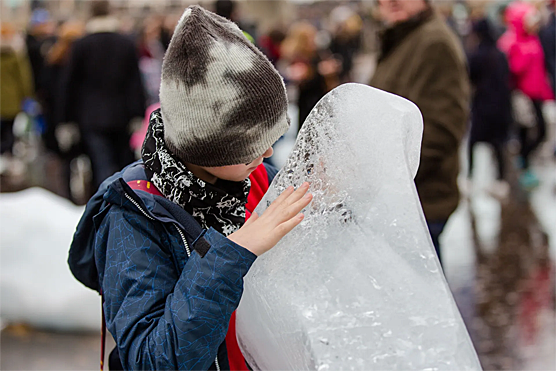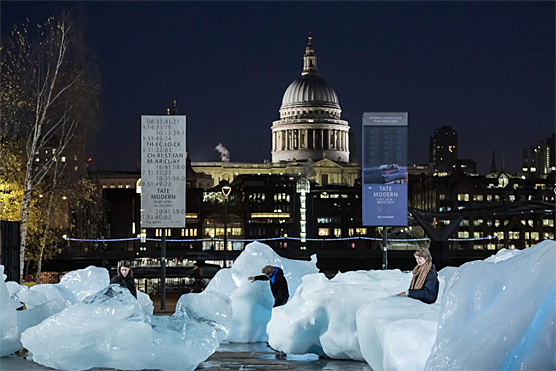July 2023 was the hottest month on record for our planet. The wildfires in the Mediterranean have impacted over 120,000 people. I feel for those in other places who have been displaced and hurt by these climate disasters. I am not alone in grieving our planet. Many of us share these feelings of grief, loss, and mourning – feelings which take shape inside our bodies.
A cognitive understanding of climate change is different from an embodied, physical, and emotional one. Seeing images or videos of melting ice is not as powerful as touching the ice and feeling it melt on your skin. This is why multisensory environmental art is vital for engaging audiences and inspiring people to think and act in the face of climate change.
Ice is symbolic
Many artists have used ice their work. Ice has symbolised an exotic yet fundamental element of our planet, being both rare and banal. It is an unconventional material to work with, because of its vulnerability to changing temperatures.
Olafur Eliasson, an Icelandic-Danish artist worked with Greenland-born geologist Minik Rosing to create a public installation piece entitled Ice Watch. The artists transported chunks of icebergs from Greenland to public places in three cities: Copenhagen (2014), Paris (2015), then London (2018).
The ice was left outside for people to interact with, as it slowly began to melt. For the Paris installation, the ice blocks weighed 112 tons, and took up space in the heart of the city.
According to Eliasson, the Ice Watch installations aimed at drawing attention to the climate crisis in a direct and tangible way. The installations coincided with the publication of the Fifth IPCC Report in 2014 and the COP21 and COP24 climate conferences in 2015 and 2018.

Children were curious about the ice chunks. Image from the Ice Watch installation at Bankside in front of the Tate Modern in London, 2018. https://olafureliasson.net/artwork/ice-watch-2014 © photo: Charlie Forgham-Bailey
Hugging, licking, and kicking the ice
People touched the ice blocks, hugged them, and listened to the sound of the ice crackling as it melted. Some children licked the ice, while others kicked it. Visitors captured moments of crying and tears and posted these images online. The multisensory installation allowed people to experience the ice through their senses and bodies. It was this very engagement with the ice that made the artwork impactful.
Mateusz Chaberski, Assistant Professor at the Department for Performativity Studies of the Jagiellonian University in Kraków, writes about ecological awareness as something that we gain through our physical bodies. It was this very ecological awareness that I experienced myself on a trip to Lapland this winter. I was excited to roam around a new region, and to experience the extreme Nordic climate for the first time.
A friend and I sat together on a frozen lake and listened to the wind. The thick ice layer supported the weight of our bodies. With the excitement came a wave of sadness. My heart broke for the beautiful wintery landscape that I knew was slowly disappearing.

Seeing photos and videos of melting ice are not as impactful as feeling the ice yourself. Image from the Ice Watch installation at Bankside in front of the Tate Modern in London, 2018. https://olafureliasson.net/artwork/ice-watch-2014 © photo: Justin Sutcliffe
Artists as pedagogues of the climate crisis
Artists have an interesting role to play, as teachers and pedagogues of the climate crisis. Their work can contribute to cultivating ecological awareness. I’m not saying that touching ice blocks will make someone a climate activist, or that it will radically transform their lives. Rather, having an emotional reaction to the ice (like crying or curiosity), can spark something within people, even on a small and subconscious level.
Environmental art impacts everyone in different ways, and its reception by the audience can be unexpected. Instead of feeling inspiration, drive, or curiosity, people can also be left feeling powerless and defeated. Was this why some people had an urge to kick and destroy the ice at the installation?
Art has always been a wonderful vector for learning, teaching, recording history, and building community. As such, artists play a crucial role in our current era of climate disaster. Using the body as a starting and ending point in art, climate change awareness, and activism is the most impactful way forward. In this moment, we cannot forget the physical body.
Emma de Carvalho is an intern in Syke's Nature solutions unit. After living in France and England, Emma moved to Finland to pursue a Master’s degree in Sociology, where her interests are in climate, art and bodies. At home she is slowly working on a rya (in Finnish “ryijy”).
Read more
Burke, Miriam, et al. “Participatory arts and affective engagement with climate change: the missing link in achieving climate compatible behaviour change?” Global Environmental Change, volume 49, 2018, pp. 95-105.
Chaberski, Mateusz. “Beyond language: knowing with abiota in contemporary installation art.” European Journal of Theatre and Performance, number 3, 2021, pp. 390-431.
Eliasson, Olafur. “Ice Watch, Artwork, Studio Olafur Eliasson.” Studio Olafur Eliasson, 2014.
Joint Research Centre. “Wildfires in the Mediterranean: monitoring the impact, helping the response.” European Commission, 28 July 2023.
Reiss, Julie. “Terra incognita: exhibiting ice in the Anthropocene.” Minding Nature, volume 12, number 2, 2019, pp. 20-26.
Opinions of blog contributors do not necessarily reflect the official views and opinions of the Finnish Environment Institute.